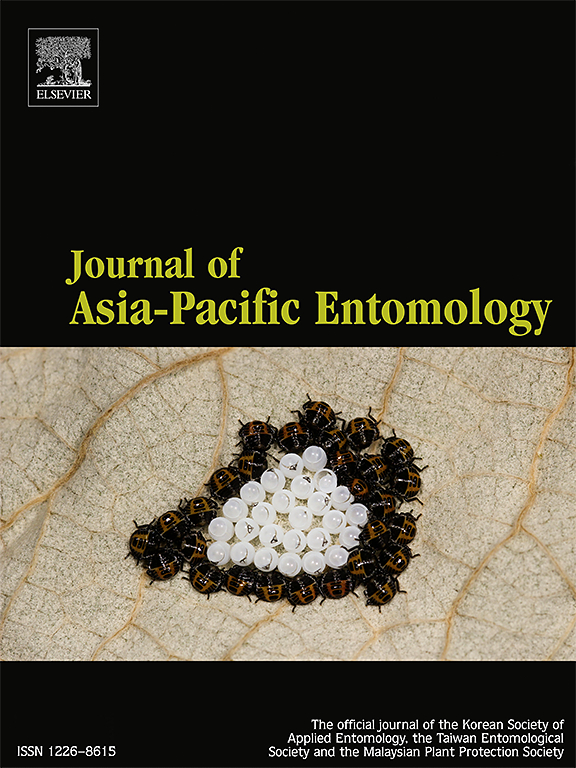Repellent activity of nanocrystalline ammonium paratungstate on the German cockroach, Blattella germanica (L.)
IF 1.3
3区 农林科学
Q3 ENTOMOLOGY
引用次数: 0
Abstract
Metal-based nanomaterials’ action as a repellent against the German cockroach, Blattella germanica (Blattodea: Ectobiidae), was examined. After the inner surfaces of black non-transparent rectangular plastic cases were sprayed with colloidal solutions of nanocrystalline ammonium paratungstate or pure water, two black cases were placed as shelters in a large container. Then adult cockroaches were introduced into the container. Cockroaches in shelters were counted 1–3 h later. When using boxes sprayed with 3.0 % colloidal solution and pure water, no cockroach that entered either of the shelters chose the shelter with nanocrystalline ammonium paratungstate. Even with concentrations lower than 3.0 %, fewer cockroaches chose shelters sprayed with the nanomaterial solution over those sprayed with pure water. The repellent effects persisted for 90 days and then decreased gradually. When cockroaches were reared in the container sprayed with the colloidal solution for a week, mortality was only 6 %, which was not different from that of the control experiment. Chemical insecticides in human dwellings pose a risk of human exposure. By contrast, a low impact on human health is expected from the non-volatile nanomaterial used for this study, which shows persistent repellency lasting for several months. Nanocrystalline ammonium paratungstate can be a strong tool when used as part of integrated pest management for cockroaches.

仲钨酸铵纳米晶对德国小蠊的驱避作用
研究了金属基纳米材料对德国小蠊(Blattella germanica)的驱蚊作用。在黑色不透明矩形塑料盒的内表面喷上纳米晶仲钨酸铵或纯水的胶体溶液后,将两个黑色盒子放置在一个大容器中作为庇护所。然后将成年蟑螂放入容器中。1 ~ 3 h后对收容室内的蜚蠊进行计数。当使用喷有3.0%胶体溶液和纯净水的盒子时,进入任何一个庇护所的蟑螂都没有选择含有纳米晶仲钨酸铵的庇护所。即使浓度低于3.0%,蟑螂选择喷洒纳米材料溶液的庇护所比喷洒纯净水的庇护所要少。驱避效果持续90 d后逐渐减弱。在喷有胶体溶液的容器中饲养一周,死亡率仅为6%,与对照实验无明显差异。人类住所中的化学杀虫剂构成人类接触的风险。相比之下,本研究中使用的非挥发性纳米材料对人类健康的影响较小,其驱避效果持续数月。纳米晶仲钨酸铵可以作为一个强大的工具,当使用作为害虫综合管理蟑螂的一部分。
本文章由计算机程序翻译,如有差异,请以英文原文为准。
求助全文
约1分钟内获得全文
求助全文
来源期刊

Journal of Asia-pacific Entomology
Agricultural and Biological Sciences-Insect Science
CiteScore
2.70
自引率
6.70%
发文量
152
审稿时长
69 days
期刊介绍:
The journal publishes original research papers, review articles and short communications in the basic and applied area concerning insects, mites or other arthropods and nematodes of economic importance in agriculture, forestry, industry, human and animal health, and natural resource and environment management, and is the official journal of the Korean Society of Applied Entomology and the Taiwan Entomological Society.
 求助内容:
求助内容: 应助结果提醒方式:
应助结果提醒方式:


